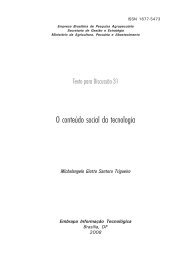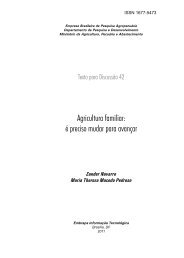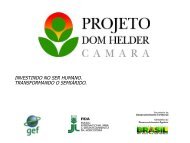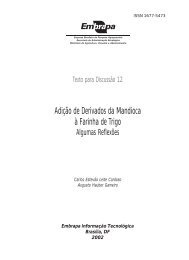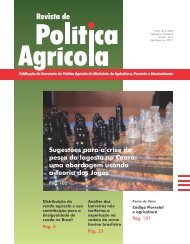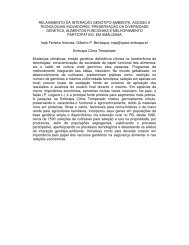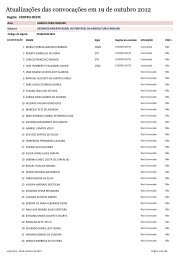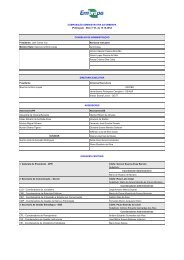Ministry of Agriculture, Livestock and Food Supply - Embrapa
Ministry of Agriculture, Livestock and Food Supply - Embrapa
Ministry of Agriculture, Livestock and Food Supply - Embrapa
You also want an ePaper? Increase the reach of your titles
YUMPU automatically turns print PDFs into web optimized ePapers that Google loves.
the possibility <strong>of</strong> earmarking new l<strong>and</strong>s to energy farming without having to<br />
reduce the food-crop farmed area or impose environmental impacts beyond<br />
what is socially acceptable. In addition, in many areas <strong>of</strong> the country it is<br />
possible to harvest several time a year without irrigation. With irrigation, the<br />
number <strong>of</strong> harvests increases considerably.<br />
Brazil's location in the tropical <strong>and</strong> subtropical zones <strong>of</strong> the world ensures<br />
intense solar radiation year-round, the basis <strong>of</strong> bioenergy production. In addition,<br />
the country is blessed with a wide range <strong>of</strong> climates <strong>and</strong> an exuberant<br />
biodiversity, as well as one-fourth the world's fresh water reserves.<br />
Brazil has successfully taken on the leadership in the generation <strong>and</strong><br />
implementation <strong>of</strong> modern, tropical agriculture technology <strong>and</strong> has a robust<br />
agro-industry. A striking example is the ethanol production chain, known as<br />
the most efficient in the world, driven by a dynamic business sector<br />
accustomed to innovating <strong>and</strong> running risks.<br />
Lastly, the consumer market is sufficiently large to enable scale gains<br />
that would reinforce competitiveness in the domestic bioenergy business <strong>and</strong><br />
support its expansion into the world biomarkets.<br />
In the short term, the environmental pressures to replace fossil fuels as<br />
the main source <strong>of</strong> energy will drive the dem<strong>and</strong> for agroenergy. Atmospheric<br />
CO concentrations in the atmosphere have increased by 31% in the last 250<br />
2<br />
years. Fossil fuel burning <strong>and</strong> cement production account for 75% <strong>of</strong> carbon<br />
emissions.<br />
To establish a framework <strong>and</strong> provide orientation for public <strong>and</strong><br />
private actions aiming at the generation <strong>of</strong> knowledge <strong>and</strong> technologies<br />
that contribute to the sustainable production <strong>of</strong> energy through<br />
agriculture <strong>and</strong> to the rational use <strong>of</strong> this renewable energy. Its goal is<br />
to ensure the competitiveness <strong>of</strong> Brazilian agribusiness <strong>and</strong> support<br />
specific public policies, such as social inclusion, regional development<br />
<strong>and</strong> environmental sustainability.<br />
The overall purpose <strong>of</strong> the National Agroenergy Plan on the basis <strong>of</strong> the<br />
facts <strong>and</strong> premises cited above is:<br />
Achieving the overall purpose implies realizing certain specific objectives,<br />
in conformity with Brazilian public policies, in order to meet the expectations<br />
<strong>of</strong> society <strong>and</strong> the dem<strong>and</strong>s <strong>of</strong> the clients:<br />
8



